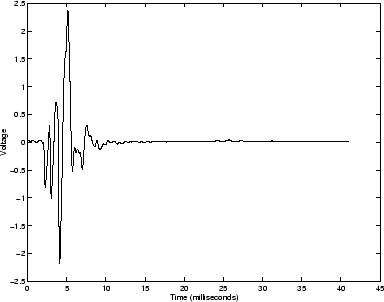 |
Figure 5.4 shows the reflections measured at the microphone from a test object consisting of stepped cylinders. A schematic diagram of the stepped tube attached to the source tube is shown in figure 5.5. A coupler is attached to the source tube which contributes a 50 mm long section with a radius of 5 mm (the same as the source tube) to the bore of the object. The first section of the stepped tube object is 129 mm long with an internal radius of 6.25 mm and the second section is 177 mm long with an internal radius of 9.4 mm. At the end of the second section, the object is open, allowing sound to radiate.
The pressure signal can be understood as follows. Since the recording is triggered to start just before the reflections from the test object arrive at the microphone, the first few milliseconds consist only of background noise. There is no significant reflection of sound between the cylindrical source tube and the first section of the test object since the radii match. There is then a negative spike corresponding to the reflection of the input pulse from the expansion at the first step. The second negative spike corresponds to sound transmitted into the second section of test object, then reflected from the expansion at the second step before transmission to the microphone. The only sign change is due to the reflection from the expansion because transmission is always positive. The third negative spike is the component of the input pulse that is transmitted to the open end where it receives a negative reflection and is transmitted back to the microphone. These are the primary reflections, where the input pulse experiences only one reflection process before reaching the microphone. The remaining parts of the recorded pressure signal are secondary reflections where the pulse experiences at least one reflection back down towards the open end before returning to the microphone.